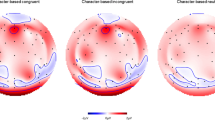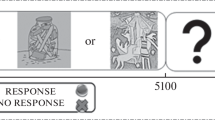Abstract
In this study, the narrativity of pictures is evaluated using behavioral scales and subconscious processes. The narrative context of the stimulus pictures was classified into four different Levels. For eliciting evoked potentials (EPs), a P300-based picture ranking system was adopted. The EPs were analyzed on significant differences between seen/unseen and Levels of the pictures. In the first paradigm, pictures were continuously presented for 15 s, and the subjects were asked to focus on the picture’s narrative. In the second paradigm, the pictures were randomly flashed, whereby one of the previously presented images was chosen as the target and unseen (non-target) pictures across Levels. The preliminary results from this Work in Progress (WIP) study show that seen images cause significantly different EPs compared to unseen images, especially in pictures with abstract and dramatic narratives. Therefore, target stimuli are ranked higher by the picture ranking system. In addition, the N600 potential is evident with abstract narrative stimuli, which have been previously reported to indicate memory function and post-perceptual processing. Further investigation will focus on differences in ERPs and ranking results across Levels and the extraction of possible EEG-biomarkers for narrative Levels in visual stimuli.
Access this chapter
Tax calculation will be finalised at checkout
Purchases are for personal use only
Similar content being viewed by others
References
Escalas, J. E. (2007). Self‐referencing and persuasion: Narrative transportation versus analytical elaboration. Journal of Consumer Research, 33, 421–429. https://doi.org/10.1086/510216
Kalaganis, F. P., Georgiadis, K., Oikonomou, V. P., et al. (2021). Unlocking the subconscious consumer bias: A survey on the past, present, and future of hybrid EEG schemes in neuromarketing. Frontiers in Neuroergonomics, 2.
Nanay, B. (2009). Narrative pictures. Journal of Aesthetics and Art Criticism, 67, 119–129. https://doi.org/10.1111/j.1540-6245.2008.01340.x
Ryan, M.-L. (2007). Toward a definition of narrative. In D. Herman (Ed.), The Cambridge companion to narrative (1st ed., pp. 22–36). Cambridge University Press.
Jääskeläinen, I. P., Klucharev, V., Panidi, K., & Shestakova, A. N. (2020). Neural Processing of Narratives: From Individual Processing to Viral Propagation. Frontiers in Human Neuroscience, 14, 253. https://doi.org/10.3389/fnhum.2020.00253
Birba, A., Beltrán, D., Martorell Caro, M., et al. (2020). Motor-system dynamics during naturalistic reading of action narratives in first and second language. NeuroImage, 216, 116820. https://doi.org/10.1016/j.neuroimage.2020.116820
Cohen, M. X. (2008). Assessing transient cross-frequency coupling in EEG data. Journal of Neuroscience Methods, 168, 494–499. https://doi.org/10.1016/j.jneumeth.2007.10.012
Dini, H., Simonetti, A., Bigne, E., & Bruni, L. E. (2022). EEG theta and N400 responses to congruent versus incongruent brand logos. Science and Reports, 12, 4490. https://doi.org/10.1038/s41598-022-08363-1
Pritchard, W. S. (1981). Psychophysiology of P300. Psychological Bulletin, 89, 506–540. https://doi.org/10.1037/0033-2909.89.3.506
Harauzov, A. K., Shelepin, Y. E., Noskov, Y. A., et al. (2016). The time course of pattern discrimination in the human brain. Vision Research, 125, 55–63. https://doi.org/10.1016/j.visres.2016.05.005
Sutaj, N., Walchshofer, M., & Schreiner, L., et al. (2021). Evaluating a novel P300-based real-time image ranking BCI. Frontiers in Computer Science, 3.
Dimoka, A., Davis, F. D., Gupta, A., et al. (2012). On the use of neurophysiological tools in IS research: Developing a research agenda for NeuroIS. MIS Quarterly, 36, 679–702. https://doi.org/10.2307/41703475
Müller-Putz, G., Riedl, R., & Wriessnegger, S. (2015). Electroencephalography (EEG) as a research tool in the information systems discipline: Foundations, measurement, and applications. Communications of the Association for Information Systems, 37, 911–948. https://doi.org/10.17705/1CAIS.03746
Riedl, R., Fischer, T., Léger, P.-M., & Davis, F. D. (2020). A decade of NeuroIS research: Progress, challenges, and future directions. SIGMIS Database, 51, 13–54. https://doi.org/10.1145/3410977.3410980
Müller-Putz, G. R., Tunkowitsch, U., Minas, R. K., et al. (2021). On electrode layout in EEG studies: 13th annual information systems and neuroscience, NeuroIS 2021. Information Systems and Neuroscience—NeuroIS Retreat, 2021, 90–95. https://doi.org/10.1007/978-3-030-88900-5_10
Riedl, R., Minas, R., Dennis, A., & Müller-Putz, G. (2020). Consumer-grade EEG instruments: Insights on the measurement quality based on a literature review and implications for NeuroIS research (pp. 350–361).
Busselle, R., & Bilandzic, H. (2009). Measuring narrative engagement. Media Psychology, 12, 321–347. https://doi.org/10.1080/15213260903287259
Joshi, A., Kale, S., Chandel, S., & Pal, D. (2015). Likert scale: Explored and explained. BJAST, 7, 396–403. https://doi.org/10.9734/BJAST/2015/14975
Cai, X., Ding, C., Nie, F., & Huang, H. (2013). On the equivalent of low-rank linear regressions and linear discriminant analysis based regressions.
Althen, H., Banaschewski, T., Brandeis, D., & Bender, S. (2020). Stimulus probability affects the visual N700 component of the event-related potential. Clinical Neurophysiology, 131, 655–664. https://doi.org/10.1016/j.clinph.2019.11.059
Acknowledgements
This work was partially funded via the European Commission project RHUMBO—H2020-MSCA-ITN-2018-813234.
Author information
Authors and Affiliations
Corresponding author
Editor information
Editors and Affiliations
Rights and permissions
Copyright information
© 2022 The Author(s), under exclusive license to Springer Nature Switzerland AG
About this paper
Cite this paper
Schreiner, L., Dini, H., Pretl, H., Bruni, L.E. (2022). Picture Classification into Different Levels of Narrativity Using Subconscious Processes and Behavioral Data: An EEG Study. In: Davis, F.D., Riedl, R., vom Brocke, J., Léger, PM., Randolph, A.B., Müller-Putz, G.R. (eds) Information Systems and Neuroscience. NeuroIS 2022. Lecture Notes in Information Systems and Organisation, vol 58. Springer, Cham. https://doi.org/10.1007/978-3-031-13064-9_34
Download citation
DOI: https://doi.org/10.1007/978-3-031-13064-9_34
Published:
Publisher Name: Springer, Cham
Print ISBN: 978-3-031-13063-2
Online ISBN: 978-3-031-13064-9
eBook Packages: Behavioral Science and PsychologyBehavioral Science and Psychology (R0)




